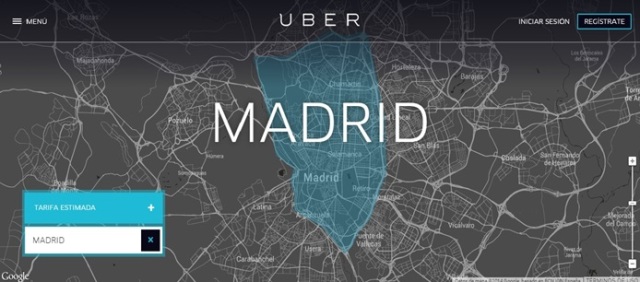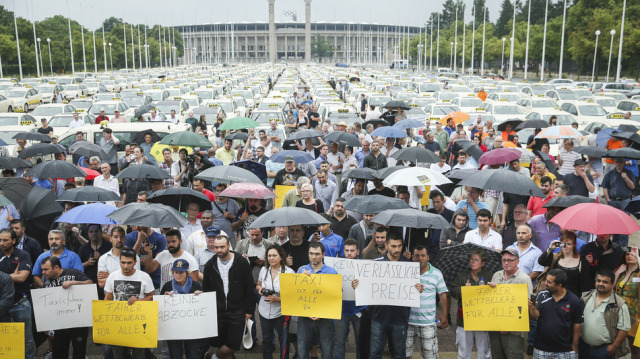The ‘Uber Effect’ in Spain:
Uber, a German language word meaning ‘over’ or ‘above’, well I don’t know what its owner was thinking while keeping that name but I think I’m starting to get a hint since the company has certainly gone both ‘over and above’(pun intended). The company is getting banished gradually from all the countries where its business is operational.
Uber began operating in Barcelona in April, and in Madrid and Valencia in October. It is a cab booking mobile app, which allows people to locate the nearest available taxi via GPS but the company does not own the cars or employ drivers (Making it easier to wriggle out of a legal mess). It puts passengers and drivers – with no license or insurance– in touch through a smart phone app, and makes a profit by keeping 20 per cent of the fare calculated by the online app (Some might call it smart business). It has expanded rapidly since its 2009 launch and now operates in more than 250 cities across 50 countries and is valued at approximately $40 billion.
A Madrid-based judge has ruled in favor of banning Uber in Spain, after numerous protests by the Madrid Taxi Association on grounds of unfair competition. They have been accused of operating illegally with no professional license and of breaking competition laws. The judge stated that the ban is temporary. The company is expected to have a chance to argue before the judge when the formal lawsuit is filed. There was no immediate comment from the company in response to the ban.
Uber’s lawyers will certainly be keeping very busy this week. After the app-based car service launched illegally in Portland last week, the city has hit back with a lawsuit. The service was also banned from Thailand on Tuesday due to regulatory issues and is under scrutiny in Vietnam. Judges in the Netherlands banned its UberPop ride-sharing service, launched as a pilot project in Amsterdam and subsequently extended to Hague and Rotterdam. Belgium, Germany, and France have threatened to ban the service due to concerns over the qualification of drivers, and protests from traditional licensed taxi services. Their protests followed similar demonstrations in London, Rome, Paris and Washington in June. In July taxi drivers in Barcelona went on strike for 24 hours to protest against the arrival of the service.
It is now official. The BBC has confirmed: Uber is dying! One more crippling bombshell hit the already beleaguered ridesharing community when IDC confirmed that Uber market share has dropped yet again, now down to less than a fraction of 1 percent of all ride-sharing services. Coming on the heels of a recent survey which plainly states that the company has lost more market share, this news serves to reinforce what we’ve known all along. Uber is collapsing in complete disarray, as fittingly exemplified by failing dead last in the recent “can you get a ride without being raped” test.
I believe Uber should be held responsible for any damage that their drivers cause, just like any other business is responsible for their employers, and that Uber cannot just claim it’s none of their business, when it is exactly all of their business. Ultimately, there should be a restriction on unlicensed taxi on the roads such as Uber. In other words, I’m surprised they exist anywhere. Though Uber may die, but they’ll just be replaced with entirely P2P systems. Once the government steps in and says “you are not allowed” they can simply take down on the server on non compliance.
Similarity between the Situation Overseas and in New Delhi:
The Spanish ban comes on the same day as a ban in New Delhi, following the alleged rape of female passenger by an Uber driver. India’s federal government warned states against allowing unlicensed Web-based taxi services. Transport authorities on Monday announced a ban on Uber services in the Indian capital, saying their investigation revealed the company was violating permit rules.
The Indian government has advised states that such ride-sharing services be registered, as taxi companies are. That would mean every driver would have to undergo a more rigorous verification process, which could very well make Uber cars safer; as things stand, all a driver needs is a “character certificate,” which can be had for as little as $130. Life in general will remain dangerous for Indian women, however, until the government takes far broader measures.
One reason Uber has become so popular among young women who can afford the service is that the alternatives—from public transport to radio taxis—are even less safe. Plus with no other public transport facility which runs 24/7, such cabs have flourished over the years as they continue with the claim to provide the ‘safest’ rides on the road, but are we even thinking once before believing on hearsay?
Machines to Patrol Streets instead of Humans:
How about a pizza being delivered at your home by an UAV (Unmanned Aerial Vehicle)? Or getting a courier through this flying machine? Or spying with a UAV as small as a butterfly which perches itself on a windowsill? Sounds like sci-fi? Experts say this could well become a reality.
While UAVs have been widely used in the West for policing, oil pipeline inspection and detecting illegal immigrants, in India, they are mainly used by the armed forces for intelligence gathering and surveillance. But this is changing. Increasingly, they’re being used for civilian purposes and are akin to God’s eye in the sky.
Getting down to serious business, in the wake of increasing challenge of ensuring safety of Delhi residents, particularly women, the Delhi Police has decided to use mini drones fitted with night-vision cameras and thermal imaging cameras for aerial surveillance in the national Capital at night. The operation will be launched within a fortnight.
Although the first of its kind project was under active consideration of the Delhi Police for the last eight to ten weeks, the recent case of rape by an Uber driver seems to have warranted the early launch of the drone service for policing. The pilot project would be first launched in North Delhi. Every drone will fly at a height of approximately 200 metres and will cover a hexagonal grid area of three to four kilometers. Technologically it will be ensured that the area covered by two drones does not overlap.
“We can further enhance its capabilities by linking each drone to a Quick Response Teams (QRT). The video can be streamed to the QRT vehicle which will monitor it in real time and respond quickly if it sees something wrong,” said a senior police official. It will also have anti-shaking software which will cancel any tremble in the video caused by the rotating blades of the flying machine and provide us steady picture.
With UAVs sending data without loss of lives, a cockpit or a pressurized cabin, they are easy come, easy go. While the next step for India will be UCAVs (unmanned combat aerial vehicles) or drones, UAVs can be used here for aerial news broadcasting, crop monitoring, aerial shots in films and infrastructure inspection of nuclear sites. The world is literally at its feet. (Just saying!)
Who do you think should be punished or for whom should the norms become stricter, uber for not doing a background check or the policeman who gave a fake character certificate for money?
Comment below to tell us what you think. We would love to hear it from you!



































